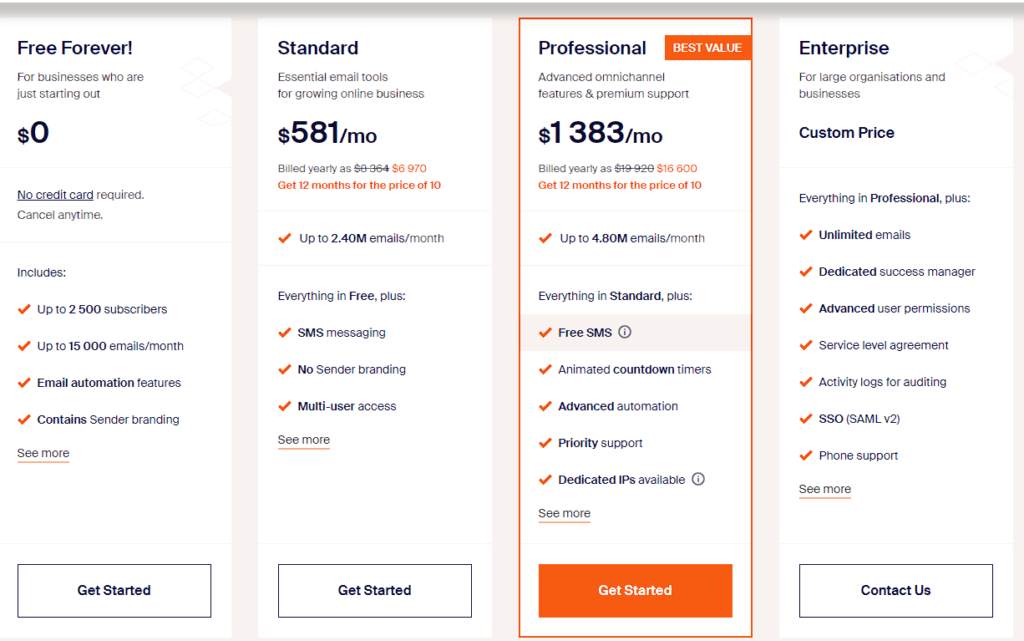This Article has been revised, edited and added to, by Poulomi Chakraborty.
- Mailchimp: The User-Friendly Giant
- Sender: The Hidden Gem of Email Marketing
- Sendinblue: The All-In-One Marketing Toolkit
- Comparing Mailchimp, Sender, and Sendinblue
- Maximizing the Effectiveness of Free Email Marketing Tools
- Conclusion
In the fast-paced world of digital marketing, email remains a cornerstone strategy for businesses of all sizes. Whether you’re a small business owner, a startup entrepreneur, or a marketing manager at a large corporation, the power of a well-crafted email campaign cannot be underestimated. But let’s face it, not everyone has the budget for fancy, high-end email marketing software. That’s where free email marketing tools come into play, offering robust features without breaking the bank. In this comprehensive guide, I’ll walk you through three of the best free email marketing tools that are changing the game for marketers everywhere. Get ready to dive deep into the world of Mailchimp, Sender, and Sendinblue!
Mailchimp: The User-Friendly Giant

Mailchimp has carved out a reputation as one of the most user-friendly email marketing tools available today. Its interface is designed with the user in mind, combining simplicity with powerful functionality. From the moment you log in, you’re greeted with a clean, organized dashboard that clearly displays your options – from creating a new campaign to reviewing the performance of your past efforts.
Navigating the Dashboard
The dashboard is the nerve center of Mailchimp’s platform, giving you quick access to your most important tools and statistics. It’s intuitively laid out, ensuring even those new to email marketing can find their way around with ease. This ease of navigation is not just about aesthetics; it’s about making email marketing accessible to everyone, regardless of their technical expertise.
Crafting and Sending Emails
Mailchimp’s strength lies in its email creation and sending capabilities. The platform offers a range of features that make designing, sending, and managing email campaigns a seamless experience.
The Email Builder: A Blend of Simplicity and Power
The email builder is a standout feature, offering a drag-and-drop interface that simplifies the design process. Whether you’re crafting a quick update to your subscribers or an intricate newsletter, the process is straightforward. You can choose from a variety of templates that cater to different needs and industries, or start from scratch if you’re feeling creative.
Personalization and Segmentation
In the world of email marketing, personalization can be a game-changer. Mailchimp provides tools that allow you to tailor your emails to individual subscribers. You can use basic personalization, like inserting a subscriber’s name in your emails, or delve into more advanced segmentation. This segmentation means you can send targeted emails based on subscriber behavior, preferences, and demographics.
Analyzing Campaign Performance
Once your emails are out in the world, Mailchimp offers robust analytics tools to track their performance. This data is crucial in understanding what resonates with your audience and what needs tweaking.
Understanding Your Audience through Data
Mailchimp’s analytics go beyond just open rates and click-through rates. They provide insights into subscriber behavior, such as which links were clicked and how subscribers interacted with your email. This information is vital for refining your strategy and ensuring your future campaigns are even more effective.
A/B Testing for Optimized Results
The platform also includes A/B testing capabilities, allowing you to experiment with different elements of your emails. You can test different subject lines, content styles, or even sending times to see what yields the best results. This kind of testing is invaluable in fine-tuning your email marketing strategy.
Pricing Plans for Startups
Understanding Mailchimp’s pricing plans is crucial for startup founders looking to maximize their budget while leveraging powerful email marketing tools. Mailchimp offers a range of pricing options that can cater to different needs and stages of business growth.
The Free plan is an excellent starting point, offering basic email marketing features and allowing you to send up to 10,000 emails per month to a maximum of 2,000 subscribers. This plan includes essential tools such as the email builder, basic templates, and simple automation features. It’s perfect for startups that are just beginning their email marketing journey and want to test the platform’s capabilities without incurring costs.
As your business grows, you may find the need for more advanced features. The Essentials plan starts at $9.99 per month and provides additional functionalities such as custom branding, A/B testing, and 24/7 email and chat support.
This plan is ideal for startups that need more flexibility and want to optimize their campaigns through testing and detailed insights.
The Standard plan, starting at $14.99 per month, offers advanced automation, retargeting ads, and detailed analytics. This plan is designed for growing businesses that require sophisticated marketing tools to manage their expanding audience and enhance engagement.
The advanced automation features enable you to create complex workflows, ensuring that your audience receives timely and relevant communication.
For larger startups or those with more complex needs, the Premium plan offers the most comprehensive set of features, starting at $299 per month. This plan includes advanced segmentation, multivariate testing, and priority support.
It’s designed for businesses that need robust tools to execute sophisticated marketing strategies and require a high level of customization and support.
Pricing Plans based on how many contacts you have:




Strategic Advice for Startup Founders
Startup founders can strategically leverage Mailchimp’s features to maximize the effectiveness of their email marketing campaigns. Begin by utilizing the Free plan to familiarize yourself with the platform.
Experiment with different templates and design elements to see what resonates with your audience. Use the segmentation and personalization tools to create targeted campaigns that address specific needs and preferences of your subscribers.
As your business grows and your needs evolve, consider upgrading to a paid plan to access more advanced features. Use A/B testing to experiment with different subject lines, content, and sending times to determine what works best for your audience. This data-driven approach can help you refine your strategies and improve your campaign performance over time.
Automation is another area where Mailchimp can add significant value. Set up automated workflows to manage tasks such as welcoming new subscribers, following up with leads, and re-engaging inactive customers. These automated sequences ensure that your audience receives consistent and timely communication without requiring constant manual effort.
Mailchimp’s integration capabilities are also crucial for creating a seamless marketing ecosystem. Connect Mailchimp with your e-commerce platform, CRM system, and social media accounts to streamline your workflows and maintain a cohesive marketing strategy.
For example, integrating Mailchimp with Shopify can automatically sync your customer data, allowing you to send targeted campaigns based on purchase history.
Real-World Application: Driving Growth with Mailchimp
To maximize your return on investment with Mailchimp, focus on creating high-quality, engaging content that provides value to your audience. Regularly analyze your campaign performance using Mailchimp’s analytics tools to identify what works and where there is room for improvement.
Pay attention to metrics such as open rates, click-through rates, and conversion rates to understand how your emails are performing and make data-driven decisions to optimize your campaigns.
Leverage Mailchimp’s extensive support resources, including tutorials, webinars, and community forums, to continuously improve your email marketing skills and strategies. By strategically utilizing the platform’s features and continuously optimizing your campaigns, you can build strong relationships with your customers, drive engagement, and achieve your marketing goals.
Mailchimp’s blend of simplicity, power, and insight makes it an invaluable tool for startup founders looking to elevate their email marketing campaigns. By understanding and leveraging its features strategically, you can create effective and engaging emails that drive growth and success for your business.
Sender: The Hidden Gem of Email Marketing

Sender, though not as widely known as some of its competitors, stands out for its exceptional balance of simplicity and functionality. This platform is a hidden gem for marketers who seek an efficient yet powerful email marketing solution.
The Intuitive Interface
The first thing that strikes you about Sender is its user-friendly interface. It’s clean, uncluttered, and straightforward, making it ideal for beginners and experienced marketers alike. The design philosophy here seems to be centered around accessibility, ensuring that even those new to email marketing can start crafting campaigns without a steep learning curve.
Crafting Effective Email Campaigns
Sender’s core strength lies in its email campaign creation tools. The platform offers a range of features that cater to both basic and advanced email marketing needs.
Easy-to-Use Email Builder
The email builder in Sender is a highlight. It offers a straightforward, drag-and-drop interface, allowing you to easily craft emails. The availability of customizable templates makes it quick and easy to create professional-looking emails that align with your brand. Whether you’re sending a simple newsletter or a complex promotional email, Sender’s builder is up to the task.
Advanced Personalization and Segmentation
Sender understands the importance of personalization in email marketing. The platform allows you to go beyond basic personalization, like using a subscriber’s name, to more complex segmentation. This means you can target specific groups of your audience with tailored messages based on their behavior, preferences, or past interactions with your emails.
Analyzing and Refining Campaigns
Understanding the impact of your email campaigns is crucial, and Sender provides robust tools to track and analyze your campaign performance.
Insightful Analytics for Data-Driven Decisions
Sender offers detailed analytics, giving you a comprehensive view of how your campaigns are performing. You can see which emails are resonating with your audience, what kind of content is driving engagement, and where there’s room for improvement. This level of insight is invaluable for refining your email marketing strategy over time.
A/B Testing for Optimizing Campaigns
The A/B testing feature in Sender is another powerful tool. You can test various elements of your emails, from subject lines to content layouts, to determine what works best with your audience. This continuous testing and optimization is key to improving the effectiveness of your email campaigns.
Pricing Plans for Startups
Understanding Sender’s pricing plans is crucial for startup founders looking to maximize their budget while leveraging powerful email marketing tools. Sender offers a variety of pricing options that cater to different needs and stages of business growth.
The Free plan allows you to send up to 15,000 emails per month to a maximum of 2,500 subscribers. This plan includes essential features such as the email builder, customizable templates, and basic automation. It’s an ideal starting point for startups that are new to email marketing and want to explore the platform’s capabilities without incurring costs.
As your business grows and your email marketing needs become more complex, you can upgrade to one of Sender’s paid plans. The Standard plan provides additional features such as advanced segmentation, automated workflows, and detailed analytics.
This plan is suitable for startups that need more flexibility and advanced tools to optimize their email campaigns. Pricing for the Standard plan is based on the number of subscribers, providing a scalable solution as your list grows.
For larger startups or those with more sophisticated marketing needs, the Premium plan offers the most comprehensive set of features. This plan includes everything in the Standard plan, plus priority support, unlimited automation sequences, and access to Sender’s API for custom integrations.
The Premium plan is designed for businesses that require robust tools and a high level of customization to execute their marketing strategies effectively.
Plans Based on how many contacts you have:


Strategic Advice for Startup Founders
Startup founders can leverage Sender’s features strategically to maximize the effectiveness of their email marketing campaigns. Begin by utilizing the Free plan to familiarize yourself with the platform and its capabilities.
Experiment with different templates and design elements to see what resonates best with your audience. Use the segmentation and personalization tools to create targeted campaigns that address specific needs and preferences of your subscribers.
As your business grows and your needs evolve, consider upgrading to a paid plan to access more advanced features. Use Sender’s advanced segmentation to target specific groups within your audience.
This could be based on behavior, such as previous purchases or engagement with past emails, or demographic information. Tailoring your messages to these segments can significantly increase open rates and conversions.
Automation is another area where Sender can add significant value. Set up automated workflows to manage tasks such as welcoming new subscribers, following up with leads, and re-engaging inactive customers. These automated sequences ensure that your audience receives consistent and timely communication without requiring constant manual effort.
Sender’s analytics tools provide valuable insights into your campaign performance. Regularly analyze metrics such as open rates, click-through rates, and conversion rates to understand how your emails are performing. Use this data to refine your strategies and improve your campaigns over time. A/B testing is particularly useful for optimizing different elements of your emails, such as subject lines, content, and sending times.
Real-World Application: Driving Engagement with Sender
To maximize your return on investment with Sender, focus on creating high-quality, engaging content that provides value to your audience. Personalize your emails to make your subscribers feel valued and understood. Use Sender’s templates and design tools to create visually appealing emails that capture attention and drive engagement.
Leverage Sender’s integration capabilities to connect the platform with other tools and platforms you use, such as your e-commerce platform, CRM system, and social media accounts. This integration streamlines your workflows and ensures that all your marketing efforts are aligned, providing a cohesive experience for your customers.
Continuously experiment with different strategies and tactics to find what works best for your business. Use A/B testing to test different subject lines, content, and sending times to optimize your email performance. Stay informed about industry trends and best practices to ensure your email marketing strategy remains effective and up-to-date.
Sender’s blend of simplicity, power, and flexibility makes it an invaluable tool for startup founders looking to elevate their email marketing campaigns. By understanding and leveraging its features strategically, you can create effective and engaging emails that drive growth and success for your business.
Sendinblue: The All-In-One Marketing Toolkit

Sendinblue distinguishes itself in the email marketing landscape by offering a suite of tools that extend far beyond email. It’s an all-encompassing platform for businesses that seek a multi-channel approach to marketing, blending email campaigns with SMS marketing and live chat functionalities.
The Comprehensive Dashboard
Upon logging into Sendinblue, you are met with a dashboard that is both comprehensive and intuitively designed. It’s a command center for all your marketing activities, not just email. This integrated approach makes it easier to manage multiple aspects of your marketing strategy from a single platform, a significant advantage for businesses looking to streamline their marketing efforts.
Mastering Email Campaigns with Sendinblue
While Sendinblue offers various marketing tools, its core remains rooted in email marketing, providing users with powerful capabilities to create and manage email campaigns.
User-Friendly Email Creation Tools
Sendinblue’s email builder is on par with the best, offering a mix of ease and functionality. With a selection of templates and a drag-and-drop editor, the platform makes it simple to design emails that are both attractive and effective. The customization options ensure that each email can be tailored to reflect your brand’s identity and message.
Beyond Basic Emails: SMS and Chat Integration
What sets Sendinblue apart is its integration of SMS and live chat features. This multi-channel approach allows businesses to engage with their audience in a more dynamic way. SMS campaigns can be a powerful tool for time-sensitive offers or updates, while the live chat feature enables real-time engagement with customers on your website.
Analytics and Insights for Informed Marketing
In any marketing effort, understanding your audience and the impact of your campaigns is crucial. Sendinblue’s analytics tools are designed to provide deep insights into your marketing efforts.
Detailed Reporting for Email and SMS
Sendinblue goes beyond basic email analytics by offering detailed reporting for both email and SMS campaigns. This dual analysis helps you understand how different channels perform and how they can be better integrated for maximum impact. The platform provides key metrics such as open rates, click-through rates, and engagement levels, enabling you to measure the success of your campaigns accurately.
Leveraging Data for Strategic Decisions
The ability to analyze and interpret this data is vital for making strategic marketing decisions. Sendinblue’s analytics help you identify trends, understand subscriber behavior, and make data-driven adjustments to your campaigns. This continuous process of analysis and optimization is key to refining your approach and achieving better results.
Pricing Plans for Startups

Sendinblue offers flexible pricing plans that cater to different business needs and budgets, making it accessible for startups at various stages of growth. The Free plan includes essential email marketing features and allows you to send up to 300 emails per day, making it a great starting point for new businesses looking to test the platform’s capabilities.
As your business grows and your email marketing needs become more complex, the Lite plan is a logical next step. Starting at $25 per month, this plan includes unlimited email sends per month, advanced statistics, and email support. It is suitable for startups that have outgrown the limitations of the Free plan and need more flexibility in their email marketing efforts.
The Essential plan, starting at $39 per month, offers additional features such as A/B testing, advanced analytics, and the removal of Sendinblue branding from your emails. This plan is ideal for startups that require more sophisticated tools to optimize their campaigns and achieve better results.
For startups looking to scale rapidly, the Premium plan provides a comprehensive set of features starting at $66 per month. This plan includes marketing automation, Facebook ads integration, landing page creation, and multi-user access, making it perfect for growing businesses that need a robust toolkit to manage their marketing efforts.
For larger startups or those with more complex needs, the Enterprise plan offers custom features and pricing. This plan provides a tailored solution with dedicated account management and priority support, ensuring that your unique requirements are met and your campaigns run smoothly.
Strategic Advice for Startup Founders
Startup founders can leverage Sendinblue’s features strategically to maximize the effectiveness of their marketing campaigns. Begin by utilizing the Free plan to familiarize yourself with the platform and its capabilities. Experiment with different templates and design elements to see what resonates best with your audience. Use the segmentation and personalization tools to create targeted campaigns that address specific needs and preferences of your subscribers.
As your business grows, consider upgrading to a paid plan to access more advanced features. Use Sendinblue’s advanced automation to set up workflows that engage your audience at different stages of their customer journey.
For example, create automated sequences for onboarding new subscribers, nurturing leads, and re-engaging inactive customers. This ensures that your audience receives consistent and relevant communication without requiring constant manual effort.
Integration is another key area where Sendinblue can add significant value. Connect Sendinblue with your e-commerce platform, CRM system, and social media accounts to streamline your workflows and maintain a cohesive marketing strategy.
For example, integrating Sendinblue with Shopify can automatically sync your customer data, allowing you to send targeted campaigns based on purchase history.
Leverage Sendinblue’s SMS marketing feature to complement your email campaigns. Use SMS for time-sensitive messages, such as flash sales or event reminders, to ensure that your audience receives important updates promptly.
The live chat feature can also enhance customer support by allowing you to engage with website visitors in real-time, answering their questions and addressing their concerns promptly.
Real-World Application: Maximizing Engagement with Sendinblue
To maximize your return on investment with Sendinblue, focus on creating high-quality, engaging content that provides value to your audience. Regularly analyze your campaign performance using Sendinblue’s analytics tools to identify what works and where there is room for improvement.
Pay attention to metrics such as open rates, click-through rates, and conversion rates to understand how your emails are performing and make data-driven decisions to optimize your campaigns.
Continuously experiment with different strategies and tactics to find what works best for your business. Use A/B testing to test different subject lines, content, and sending times to optimize your email performance. Stay informed about industry trends and best practices to ensure your email marketing strategy remains effective and up-to-date.
Utilize Sendinblue’s extensive support resources, including tutorials, webinars, and customer support, to continuously improve your email marketing skills and strategies. By strategically leveraging the platform’s features and continuously optimizing your campaigns, you can build strong relationships with your customers, drive engagement, and achieve your marketing goals.
Sendinblue’s blend of comprehensive features, ease of use, and multi-channel capabilities makes it an invaluable tool for startup founders looking to elevate their marketing campaigns. By understanding and leveraging its features strategically, you can create effective and engaging emails that drive growth and success for your business.

Related: Check out our free SEO suite

Comparing Mailchimp, Sender, and Sendinblue
As we’ve explored the individual features of Mailchimp, Sender, and Sendinblue, it’s clear that each has its unique strengths and potential drawbacks. Understanding these differences is key to selecting the right tool for your specific needs.
User Interface and Ease of Use
In the realm of user-friendliness, Mailchimp often takes the crown. Its interface is not just intuitive but also enjoyable to use, making it a favorite among beginners and seasoned marketers alike. Sender, while not as widely known, follows closely with its straightforward and clean interface, which is particularly appealing to those who prefer a no-nonsense approach. Sendinblue, with its additional features beyond email marketing, presents a slightly steeper learning curve but remains user-friendly, especially for those who appreciate having multiple tools in one platform.
Feature Set and Flexibility
When it comes to features, each tool brings something unique to the table. Mailchimp’s strength lies in its comprehensive set of tools that cater to a variety of marketing needs, though some of the more advanced features are reserved for its paid plans. Sender shines with its focus on email marketing, offering robust yet accessible tools that are perfect for small to medium-sized businesses. Sendinblue, on the other hand, offers a broader range of marketing tools, making it an ideal choice for businesses looking for an all-in-one solution.
Pricing Plans and Affordability
| Mailchimp | Free Plan: Available with basic features, suitable for up to 2,000 contacts and 10,000 sends per month with a daily limit of 2,000. Essentials Plan: Starting at around $9.99/month, this plan includes all email templates, A/B testing, custom branding, and support for up to 50,000 contacts. Standard Plan: Starting at approximately $14.99/month, this offers additional features like retargeting ads, advanced insights, and automation tools, catering to up to 100,000 contacts. Premium Plan: Starting from $299/month, aimed at larger businesses, offering advanced segmentation, multivariate testing, and unlimited seats and role-based access. |
| SendinBlue | Free Plan: Includes unlimited contacts with 300 emails per day. Lite Plan: Starting around $25/month, this plan includes no daily sending limit and is suitable for smaller businesses. Premium Plan: Starting from around $65/month, offering advanced features like marketing automation, Facebook ads, landing pages, and multi-user access. Enterprise Plan: Custom pricing with advanced and custom features, dedicated account manager, and priority support. |
| Sender | Free Plan: Up to 2,500 subscribers and 15,000 emails per month. Includes basic features like newsletters and subscription forms. Standard Plan: Starting at $11/month for up to 5,000 subscribers and 60,000 emails. Includes advanced features like autoresponders and transactional emails. Professional Plan: Custom pricing based on higher volumes of subscribers and emails, including additional features like dedicated IP and webhooks. |
Pricing is a crucial factor for startups operating on limited budgets. Mailchimp offers a Free plan that allows you to send up to 10,000 emails per month to a maximum of 2,000 subscribers. This plan includes basic features such as the email builder, basic templates, and simple automation.
As your business grows, the Essentials plan starts at $9.99 per month, providing additional features like A/B testing and custom branding. The Standard plan, starting at $14.99 per month, offers more advanced tools, while the Premium plan at $299 per month includes the most comprehensive features, catering to larger businesses with complex needs.
Sender’s Free plan allows you to send up to 15,000 emails per month to a maximum of 2,500 subscribers. This plan includes essential email marketing features, making it an excellent option for startups just beginning their email marketing journey.
The Standard plan offers advanced segmentation, automated workflows, and detailed analytics, with pricing based on the number of subscribers. The Premium plan provides unlimited automation sequences, priority support, and access to Sender’s API for custom integrations, catering to businesses with sophisticated marketing needs.
Sendinblue’s Free plan includes essential email marketing features and allows you to send up to 300 emails per day. This plan is ideal for startups looking to test the platform’s capabilities. The Lite plan, starting at $25 per month, includes unlimited email sends per month and advanced statistics.
The Essential plan, starting at $39 per month, adds A/B testing and advanced analytics. The Premium plan, starting at $66 per month, offers marketing automation, Facebook ads integration, landing page creation, and multi-user access. For larger startups, the Enterprise plan provides custom features and pricing, ensuring that your unique requirements are met.
Email Design and Customization
Email design is a critical aspect of any marketing campaign. Here, all three platforms offer robust email design tools. Mailchimp and Sendinblue provide a wide range of customizable templates, making it easy to create visually appealing emails. Sender also offers customizable templates, though the variety may not be as extensive as Mailchimp or Sendinblue. However, its templates are highly optimized for different purposes, ensuring high deliverability and engagement.
Analytics and Reporting
In today’s data-driven marketing world, analytics play a crucial role. Mailchimp offers basic analytics in its free plan, which is a great starting point for small businesses. Sender’s analytics are more detailed, giving deeper insights into subscriber behavior. Sendinblue goes a step further by integrating email and SMS analytics, offering a comprehensive view of your marketing efforts.
Limitations and Scalability
Each tool has its limitations, especially in their free plans. Mailchimp restricts the number of emails and subscribers, which might be a bottleneck for growing businesses. Sender, while generous in its limits, may lack some advanced features that larger businesses might need. Sendinblue’s daily email sending limit could be restrictive for businesses with larger email lists or those who need to send multiple campaigns in a day.

We use email marketing tools to drive engagement and outreach at TP-Link. We focus on personalized and segmented email marketing to deliver customized content for our diverse audiences.
One of the best things about our preferred tool is its powerful analytics, which gives us great insight into campaign performance to adjust our strategies for the best results.
One of the strengths of our tool is its scalability. Given our global reach, it’s critical that our platform can process large volumes of email efficiently. Our tool simplifies this process, keeping everything running smoothly, even on a large scale.
If there’s one thing I’d like to share with you, mobile optimization should be at the top of your to-do list.
After all, in today’s digital world, most users access your emails on their mobile devices, so it’s essential to ensure they’re responsive across all screen sizes.
And don’t forget to A/B test different elements, such as your subject lines, content, and calls to action. Doing so can reveal valuable insights that can help improve your campaign’s effectiveness.
While constantly testing new technologies to stay on top of the latest trends, we are not actively looking for alternatives to our email marketing tool.
Our email marketing tool is highly reliable and has a wide range of features that continue to meet our changing needs efficiently.
Laviet Joaquin, Marketing Head of TP-Link

As the owner of GoRubbishGo, I have steered our digital marketing strategies with an emphasis on sustainability, innovation, and community engagement. Our unique approach not only highlights our commitment to eco-friendly waste management but also leverages technology to measure impact and continuously refine our tactics.
Adopted Digital Marketing Strategies:
1. Content Marketing with an Eco-Focus: We’ve developed a robust content marketing strategy that emphasizes educational content around sustainability and recycling.
This includes blog posts, infographics, and video content that explains the environmental impact of waste and how our services mitigate these issues.
The result has been a significant increase in website traffic and engagement on our social media platforms.
2. Interactive Campaigns for Community Engagement: Leveraging social media, we’ve launched interactive campaigns, such as challenges and live Q&A sessions, to engage with our community on sustainability topics.
These campaigns have boosted our social media following and increased customer interaction, fostering a loyal customer base passionate about eco-friendly practices.
3. Utilizing Data Analytics for Audience Insights: By employing advanced data analytics tools, we’ve gained deep insights into our audience’s behavior and preferences.
This data-driven approach has allowed us to tailor our content and campaigns more effectively, leading to higher conversion rates and engagement.
Results and Impact:
The adoption of these strategies has led to a 30% increase in organic website traffic and a 40% growth in our social media engagement within the last year.
Moreover, our interactive campaigns have not only enhanced our brand visibility but also positioned us as thought leaders in the sustainability space.
Tracking and Optimization:
1. Performance Metrics: We closely monitor a range of key performance indicators (KPIs), including website traffic, engagement rates, conversion rates, and social media growth.
Tools like Google Analytics and social media analytics platforms are instrumental in this process.
2. Customer Feedback Loops: Feedback from our community through surveys and social media interactions provides invaluable insights, helping us to refine and adjust our strategies in real time.
3. Continuous Learning and Adaptation: We stay abreast of the latest digital marketing trends and sustainability topics, incorporating new insights and technologies into our strategy.
This agile approach ensures that our marketing efforts remain effective and aligned with our mission.
Our experience underscores the importance of aligning digital marketing strategies with core business values. By focusing on sustainability, we not only promote our services but also contribute to a larger conversation on environmental responsibility.
Daniel Anderson, CEO of GoRubbishGo

As the General Manager at DesignRush, a lively digital marketplace, I’ve embraced the challenge of standing out in the attention economy from day one.
Our unique strategies focus on data-driven customization, active engagement, and constant optimization. For instance, we adopted a symbiotic SEO and content strategy, where data analysis dictates our content creation which then further fuels our SEO efforts.
This has led to a significant increase in organic traffic and improved search engine rankings. We track these results using analytics tools such as Google Analytics and SEMrush.
Also, we’re in the process of adopting interactive and immersive experiences for our users. By integrating AR and VR, we aim to provide more engaging and personalized experiences.
These innovations are assessed using engagement metrics like dwell time and interaction rates, and learnings are applied in real-time.
In the digital age, the only constant is change, and being agile with constant optimization has been key to our success in the attention economy.
Gianluca Ferruggia, General manager at DesignRush

As the founder of CleanItSupply.com, the process of standing out digitally in the attention economy has been an engaging journey. Early on, we realized the importance of unique strategies.
One such approach was setting up a YouTube channel under the pseudonym ‘Danny D’, where we produced over 6,000 product videos – a move uncommon in our industry.
This medium allows us to enhance customer satisfaction & engagement, providing not just product details, but useful tips on using various cleaning supplies. To track the results, we pay close attention to video engagement metrics, like number of views, average view duration, likes, and subscriber growth.
We also track how much traffic is driven from YouTube to our website and how that traffic converts into sales. Ongoing optimization involves producing videos responding to trending topics, based on our customer queries, and significant changes in the cleaning and janitorial supplies industry.
This approach has built a loyal audience and driven up sales, speaking to the efficacy of our unique digital marketing strategy.
Dan Dillon, CEO of CleanItSupply.com
Maximizing the Effectiveness of Free Email Marketing Tools
Having a great tool is only part of the equation. Knowing how to effectively utilize these tools can significantly amplify your marketing efforts. Let’s delve into how you can make the most out of Mailchimp, Sender, and Sendinblue.
Crafting Engaging Content
No matter which tool you choose, the content of your emails is paramount. Engaging, relevant, and value-driven content will always outperform sales-heavy messages. Use the design and customization features of these tools to create visually appealing emails that resonate with your audience. Personalization features, like adding a subscriber’s name or customizing content based on their preferences, can greatly enhance engagement.
Segmenting Your Audience
Effective email marketing isn’t just about sending emails; it’s about sending the right email to the right person. Utilize the segmentation features available in these tools to categorize your subscribers. This could be based on their behavior, such as previous purchases, or demographic information. Tailoring your messages to specific segments can dramatically improve open rates and conversions.
Testing and Optimization
The beauty of digital marketing lies in its measurability and the ability to optimize based on data. Use the A/B testing features to test different elements of your email, such as subject lines, content, and call-to-actions. Analyze the performance of your emails through the analytics features and continuously refine your strategy based on what works best for your audience.
Integrating with Other Marketing Channels
While email marketing is powerful on its own, integrating it with other marketing channels can amplify its effectiveness. Consider how you can use these tools in conjunction with your social media, content marketing, or even offline marketing efforts. For example, Sendinblue’s SMS marketing feature can complement your email campaigns, providing another touchpoint with your audience.
Automation for Efficiency and Consistency
One of the key advantages of using tools like Mailchimp, Sender, and Sendinblue is their automation capabilities. Automating welcome emails, follow-ups, or re-engagement campaigns can save you time and ensure consistent communication with your audience. Use these features to set up email sequences that nurture your leads over time.
Staying Compliant
Lastly, it’s crucial to adhere to email marketing laws and regulations, such as GDPR in Europe or CAN-SPAM in the United States. These tools offer features to help you stay compliant, like easy-to-manage unsubscribe options and consent forms. Ensuring that your email marketing practices are compliant not only protects you legally but also builds trust with your audience.
Conclusion
As we’ve explored in this detailed guide, email marketing remains a vital component of a comprehensive digital marketing strategy, and tools like Mailchimp, Sender, and Sendinblue offer powerful features even in their free versions. Each tool has its unique strengths, and the choice ultimately depends on your specific marketing needs and goals. When selecting an email marketing tool, consider factors like the size of your email list, the types of campaigns you want to run, and any additional features you might need. Remember, the best tool is the one that aligns with your marketing objectives and grows with your business.
Email marketing is continually evolving, and these tools are constantly updating their features to keep up with the latest trends and user needs. Staying informed and adaptable to these changes will ensure that your email marketing strategy remains effective and relevant. Whether you’re a small business owner, a startup, or a marketing professional in a larger organization, harnessing the power of free email marketing tools can lead to significant growth and engagement. By understanding and effectively utilizing tools like Mailchimp, Sender, and Sendinblue, you can elevate your marketing efforts and achieve remarkable results.
Read Next
- Beauty Branding: The Secrets Behind Successful Cosmetic Brands
- Tailor Branding: How Customization Elevates Brand Perception
- Tequila Branding: The Art of Crafting a Memorable Spirit Brand
- Digital Marketing for Financial Services: Building Trust and Credibility
- Digital Marketing in the Food and Beverage Sector: Engaging Foodies Worldwide






















Comments are closed.